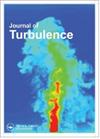MD 30P-30N三元翼型的先进分离涡模拟
IF 1.5
4区 工程技术
Q3 MECHANICS
引用次数: 0
摘要
摘要介绍了分离涡模拟(DES)系列中的一个实验版本(称为高级DES或ADES),并在相当复杂的二维几何结构上进行了测试。ADES的本质变化是,用户可以控制用全湍流模型(RANS)处理的区域和用大涡模拟(LES)处理的区域。这种区域性特征使得该方法更强大,但实用性较差,因此在目前的状态下,它还不适合工业CFD。两个区域的网格要求差别很大,多块网格结构是自然的。另一个关键特性是体积合成湍流发生器(VSTG),安装后可向LES区域提供可行的已解湍流,因此已解的雷诺应力可迅速替代RANS区域中模拟的雷诺应力。VSTG在一个体积内工作,而不是在一个表面上工作,可以在附着的边界层、尾缘或分离后工作。著名的麦克唐纳-道格拉斯30P-30N翼型是模拟周期性横向边界条件。VSTG是成功的,并且在每个区域都获得了期望的仿真性质。ADES涉及区域决策,但看起来很稳健。惯性范围在频谱中清楚地表示出来。包括网格细化研究,以及横向域大小和STG位置的变化;这导致了一个包含11个模拟的矩阵。病例显示为四个攻角,除ADES外还有三种RANS模型。详细比较了压力和摩擦分布、速度和剪应力分布。讨论了从长远来看,ADES发展成为一种实用的常规方法的前景。关键词:先进分离涡模拟多单元机翼三单元大升力翼型所有计算均使用圣彼得堡彼得大帝理工大学(http://www.spbstu.ru;在国家物理和数学中心的科学计划框架内,第2部分“zeta -scale和Exa-scale超级计算机的数学建模”,于2023年8月24日访问。阶段2023 - 2025年”。披露声明作者未报告潜在的利益冲突。本研究由俄罗斯联邦科学和高等教育部资助:[资助号075-15-2022-311]。本文章由计算机程序翻译,如有差异,请以英文原文为准。
Advanced detached-eddy simulation of the MD 30P-30N three-element airfoil
AbstractAn experimental version in the Detached-Eddy Simulation (DES) family (called Advanced DES or ADES) is introduced and tested on a geometry that is fairly complex but two-dimensional. The essential change in ADES is that the user is given control of the regions treated with full turbulence modelling (RANS) and those treated with Large-Eddy Simulation (LES). This zonal character makes the approach more powerful, but less practical, so that in its current state it is not ready for industrial CFD. The grid requirements of the two regions are very different, and multi-block grid structure is natural. Another key feature is a Volumetric Synthetic Turbulence Generator (VSTG), installed to feed the LES region with viable resolved turbulence, so that the resolved Reynolds stresses rapidly substitute for the modelled Reynolds stresses present in the RANS region. The VSTG operates in a volume, rather than on a surface and can be active in attached boundary layers, at a trailing edge, or after separation. The well-known McDonnell-Douglas 30P-30N airfoil is simulated with periodic lateral boundary conditions. The VSTG is successful, and the desired nature of simulation is obtained in each region. ADES involves zonal decisions, but appears robust. An inertial range is clearly indicated in frequency spectra. A grid-refinement study is included, as well as variations in lateral domain size and STG positions; this led to a matrix of 11 simulations. Cases are shown at four angles of attack and with three RANS models in addition to ADES. Pressure and friction distributions and velocity and shear stress profiles are compared in detail. The prospects for an evolution of ADES into a practical routine approach in the long term are discussed.KEYWORDS: Advanced detached-eddy simulationmulti-element wings3-element High-lift airfoils AcknowledgementsAll the computations were conducted with the use of the HP computing facilities of the Peter the Great Saint-Petersburg Polytechnic University (http://www.spbstu.ru; accessed on August 24 2023) within the framework of the scientific program of the National Center for Physics and Mathematics, section #2 ‘Mathematical modeling on Zetta-scale and Exa-scale Supercomputers. Stage 2023-2025’.Disclosure statementNo potential conflict of interest was reported by the author(s).Additional informationFundingThis work was supported by Ministry of Science and Higher Education of the Russian Federation: [Grant Number 075-15-2022-311].
求助全文
通过发布文献求助,成功后即可免费获取论文全文。
去求助
来源期刊

Journal of Turbulence
物理-力学
CiteScore
3.90
自引率
5.30%
发文量
23
审稿时长
6-12 weeks
期刊介绍:
Turbulence is a physical phenomenon occurring in most fluid flows, and is a major research topic at the cutting edge of science and technology. Journal of Turbulence ( JoT) is a digital forum for disseminating new theoretical, numerical and experimental knowledge aimed at understanding, predicting and controlling fluid turbulence.
JoT provides a common venue for communicating advances of fundamental and applied character across the many disciplines in which turbulence plays a vital role. Examples include turbulence arising in engineering fluid dynamics (aerodynamics and hydrodynamics, particulate and multi-phase flows, acoustics, hydraulics, combustion, aeroelasticity, transitional flows, turbo-machinery, heat transfer), geophysical fluid dynamics (environmental flows, oceanography, meteorology), in physics (magnetohydrodynamics and fusion, astrophysics, cryogenic and quantum fluids), and mathematics (turbulence from PDE’s, model systems). The multimedia capabilities offered by this electronic journal (including free colour images and video movies), provide a unique opportunity for disseminating turbulence research in visually impressive ways.
 求助内容:
求助内容: 应助结果提醒方式:
应助结果提醒方式:


